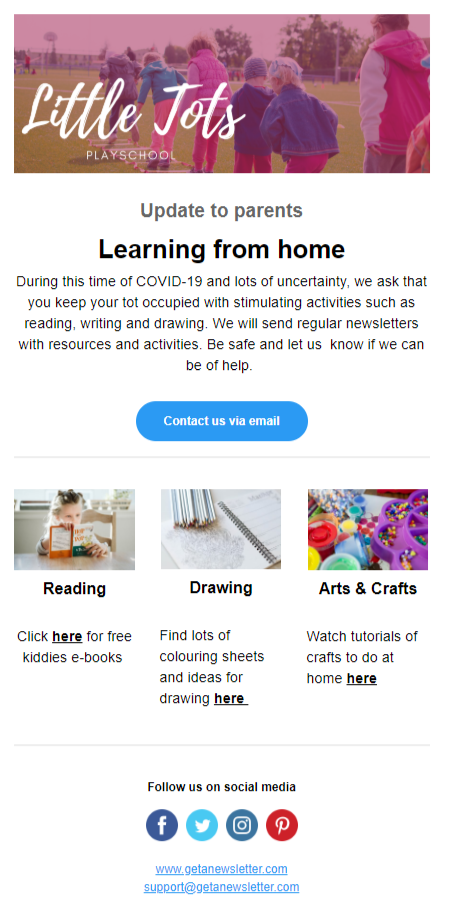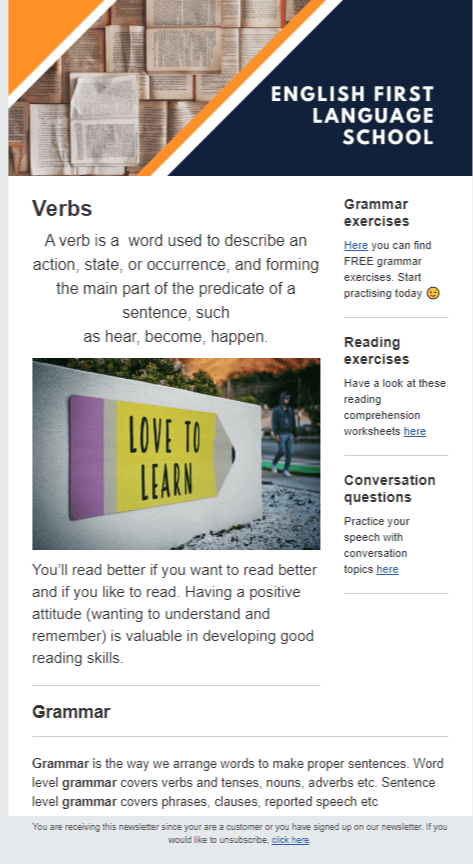The effects of the Coronavirus are being felt the world over as more countries go into lockdown and more people practice social distancing. Because no one is sure of how long these measures will be in place, people have started to think of how education can continue from home during the COVID-19 outbreak.

Schools and private education businesses (e.g. English language schools and private tutoring companies) are probably one of the worst affected sectors in this pandemic because of the disruption to in-person classes.
But all hope is not lost, there are ways that you can get back to teaching and learning.
Table of Contents
- Education sectors response to coronavirus
- What can parents do at home to continue their education?
- How can adult students learn from home?
- Use email newsletters to communicate
- How can language schools use newsletters?
- Why you should use newsletters during the coronavirus
- FREE templates to use
It’s going to take a few minutes to get everything set up, but you can start TODAY.
Students the world over are panicking – rightly so because they have been sent home from their dorms and hostels. International students have been called home. Their education was stopped abruptly. Lecturers and teachers are waiting for instructions from their government and leaders. And no one is sure when classes will be back to normal again.
How have educational centers responded to the coronavirus?
When the World Health Organisation recommended social distancing as a way to stop the virus from spreading, people across the world were slow to act.
Fast-forward a few weeks later and we understand why group gatherings should be canceled.
Government schools and educational institutions across the world closed down. Some schools had semester breaks and holidays scheduled – but at the time, no one had a solid plan of how teaching and learning were going to continue.
Some countries decided to close down schools and educational centers nation-wide, like:
- China
- Italy
- Ireland
- Saudi Arabia
- Germany
- Sweden
- Argentina
- Mexico
Other countries have localized school closures, which means that individual schools can decide if they want to close, like:
- Australia
- Brazil
- USA
- Canada
- Greenland
- Russia
Private education businesses, like language schools and tutoring companies, were hit hard as well unless they already had a system in place for online learning – like video calling and online forums.
How are parents continuing kids’ education during the coronavirus?
Because of the sudden closure of schools and colleges, parents who are still working (even from home) have been left scrambling to find childminders to watch their young children.
That is kind of difficult because people are careful not to spread the coronavirus and in countries where there’s a total lockdown, people are not allowed to leave their houses.
You definitely want to keep young kids busy during this time – and not only with Netflix and games.
Here’s how you do that:
#1 Set out a time for reading books
If you have books at home great! Now is the time to get stuck in and start reading with your young child. If you’re stuck inside with no books, find some websites where you can download free kids’ books. If you have a subscription to an e-book site, let your kids search for books they’d like to read.
#2 Download printable coloring pages and encourage a bit of creativity!
Get the creative juices flowing and start coloring, painting, or drawing. There are loads of printable coloring sheets on Pinterest. If you don’t have crayons or a printer, you might consider downloading an app – not half as fun but it will do.
#3 Play educational games
Crossword puzzles, word searches, and maths games can be fun and educational. Play in teams or take turns with who gets to pick the game. Board games and cards can also kill a lot of time and encourage independent thinking and decision-making.
#4 Write stories – this is the time to let kids’ minds wander
Even if your child is not creative, if she has enough time to think and feel a bit inspired, she can come up with a great story. Writing is also an important skill to learn when they are older.
#5 Start a new hobby
Like baking, knitting, or starting a small vegetable garden – watch a couple of how-to videos online and get started.
#6 Art and Crafts
Kids love making a mess, allow them to! There are lots of crafts with instructions on Pinterest and try YouTube for some tutorial videos.

Parents should also have an honest conversation with their child and explain what’s going on and why the school had to close, or why people are wearing masks and avoiding contact with other people.
Unicef gave some suggestions on how to talk to children about the coronavirus.
Here’s a quick summary:
- Ask questions and listen – drawings, stories, and games might help to open the discussion.
- Encourage hygiene – show them how to wash their hands and how to cover a sneeze with their elbow
- Offer reassurance – talk to them often to keep them calm, don’t want the news around them. It might scare them to hear of everything that’s happening.
How can schools and colleges continue education and encourage learning from home?
Everyone is saying – to take everything online! Churches and businesses have had great success with social media platforms, workflow software, and video calling for meetings. The whole nine yards.
But hang on a second!
Schools and colleges are different though – it’s not just moving a small team of people to an online platform. It’s thinking of ways to *consistently* help hundreds (and sometimes thousands) of students continue their education during this time.
So video calling might be great but with hundreds of students – it’s a huge task and there probably won’t be enough time to get to everyone.

Here are some suggestions on how to continue education:
#1 Create a Microsoft PowerPoint with a voice-over or video
MS PowerPoint has recording functions – you can do voice and video recordings per slide. Use this to present lecture/class content to students. Prep by having a little script of what you want to say on each slide.
Your students will appreciate the effort.
#2 Group video call for small group sessions
For group tutorials and discussion, why not try a group video call? Some colleges and universities support Microsoft Teams. Zooms removed the 45-minute call limit on their free basic accounts for K-12 schools in Canada, Germany, and the UK.
#3 Use quizzes for assessments
Instead of loads of written assignments, which would be very difficult with no in-person lectures or the opportunity to ask detailed questions, you could do quizzes (e.g. on Google Forms) and grade students that way.
#4 Give students one large research task that they can complete over three weeks
If quizzes are not your thing you can try a larger research task (that counts for more marks!) and give students three weeks to complete that. Give clear and detailed instructions in a PowerPoint with a voice-over.
#5 Make video recordings of lectures and post them online
Making recordings of lectures are nothing new, but during the coronavirus it is necessary. Think of how helpful it will be if students can actually hear a familiar voice or see their teacher explaining course content – this works great for subjects with calculations (like maths or accounting).
#6 Create chat groups for Q&As
Education happens when we learn from each other. So where students would normally ask questions in class, they can’t right now. So move that Q&A to a chat forum online. The teacher can ask a question to start the discussion and encourage students to participate by answering and asking questions of their own.
The biggest problem during the coronavirus is maintaining a consistent flow of communication and letting students and parents know what’s changing.
Keep in touch via email newsletter
Schools and colleges can send email newsletters with resources for students to use at home during the coronavirus, for example, links to e-learning websites, YouTube videos explaining subject content, and links to exercises that they can try at home.
For young children, schools should send these newsletters to parents. Also, make sure that the links in the kid’s newsletters are child-friendly, or put these resources on the school website (or create a Facebook page for the parents).
They can also include a separate newsletter just for the parents – with tips on how to keep a young child busy at home during the coronavirus and what educational activities to do per age group.

How can private education businesses use email newsletters?
Private education companies like language schools and tutoring companies can use email newsletters during the coronavirus to:
- Inform their students of what’s happening to their classes during this time
- Explain coursework in an interactive way (e.g. how to use verbs in a sentence with a link to an exercise)
- Compile resources and send them in a newsletter (e.g. websites with free maths exercises)
- Give links to video tutorials on their website
Why use newsletters to communicate during the coronavirus?
Because schools and colleges can communicate via regular email right?
Yes, they can, but the benefits of email newsletters outweigh that of normal email.
> Email newsletters can be scheduled – which means you can spend time creating lots of newsletters and schedule them to be sent a few days apart. After that’s done, you can kind of forget about it.
> Segment audience – create custom mailing lists and send newsletters to that specific group in a few clicks (e.g. Group 1 = Class 2 parents; Group 2 = Class 7 parents).
> Newsletters are interactive – you can include links to other pages, resources, and websites. It’s also a great way to compile resources by topic (e.g. Top 10 maths websites for Class 11)
> They are not wordy – unlike regular email, you can use pictures and a few words to deliver a message. No more long paragraphs.
> Make sequences – you can make sequences of email newsletters (e.g. 4 newsletters on the same topic) and schedule them to be sent out at short intervals (e.g. every 4 days). This way, the 1 topic can be covered in more detail.
Template 1: Playschool

Template 2: Language school

Template 3: College

To use these templates and more, SIGN UP for a free account today
Leave a Reply